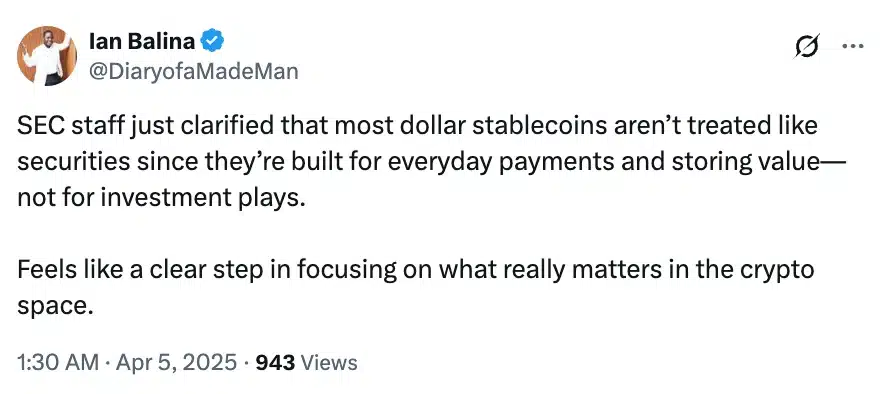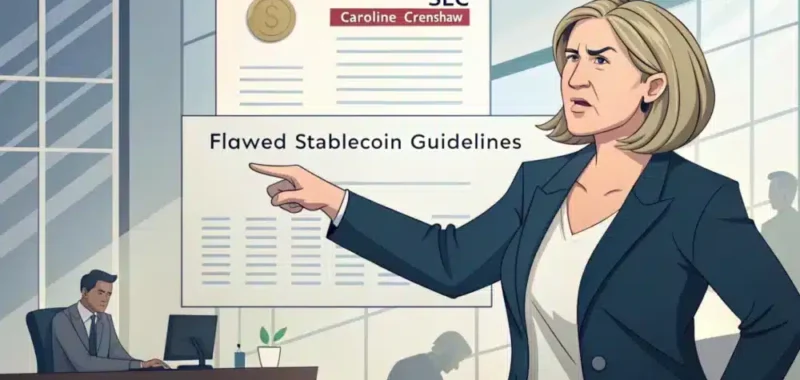- SEC’s stablecoin guidelines were criticized by Commissioner Crenshaw for misrepresenting risks and legal facts.
- The stablecoin market faces scrutiny as Tether engages in asset audits and legislative moves.
In a sharp rebuke of her own agency, U.S. SEC Commissioner Caroline Crenshaw has publicly criticized the regulator’s newly issued guidelines on stablecoins, accusing it of misrepresenting both legal interpretations and risk factors.
Caroline Crenshaw slams SEC’s stablecoin guidelines
Known for her hard stance against spot Bitcoin ETFs, Crenshaw argued in a statement that the SEC’s latest position downplays the vulnerabilities of the USD-backed stablecoin market and riddles it with both legal and factual flaws.
While the new framework classifies certain stablecoins as “non-securities” and relaxes reporting requirements, Crenshaw contends that the agency glosses over critical safeguards and overstates the effectiveness of issuer mechanisms designed to reduce risk.
For those unaware, the SEC had earlier noted,
“Some USD-stablecoins are available to retail purchasers only through an intermediary and not directly from the issuer.”
Crenshaw pushed back against the SEC’s conclusions, asserting they were misleading and failed to capture the true risks.
She said,
“It is the general rule, not the exception, that these coins are available to the retail public only through intermediaries who sell them on the secondary market, such as crypto trading platforms.”
Crenshaw added,
“Over 90% of USD-stablecoins in circulation are distributed in this way.”
Mixed reaction from the crypto community
While some in the crypto community welcomed the SEC’s clearer stance on stablecoins, with figures like Token Metrics founder Ian Ballina describing it as a step toward focusing on key issues, others expressed concern.

Source: Ian Balina/X
Vemanti CEO Tan Tran wished the SEC had adopted such clarity earlier and said,
“Thank you for the clarification, @SECGov. Wish you had arrived at this same conclusion 3 years earlier…No matter, better late than never. We’re working on relaunching the @Vemanti $VMNT USDV stablecoin.”
Ian Kane of Midnight Network viewed it as progress for crypto enthusiasts abiding by regulations and said,
“Overall, this feels like progress for crypto folks trying to play by the rules. Is this complete regulatory clarity? Nope. It’s a signal. If you’re building stable, transparent, and boring-in-a-good-way financial tools, there may be a compliant path forward.”
However, Crenshaw took issue with the SEC’s reassurances, calling it “grossly inaccurate” to suggest that issuers could handle unlimited redemptions simply because their reserves meet or exceed supply.
She added,
“The issuer’s overall financial health and solvency cannot be judged by the value of its reserve, which tells us nothing about its liabilities, risk from proprietary financial activities, and so forth.”
Stablecoin market current condition
That being said, Crenshaw’s concerns come at a time when the stablecoin market is under increasing scrutiny.
Just weeks prior, Tether had reportedly engaged a Big Four accounting firm to audit its asset reserves, ensuring its USDT stablecoin maintains a 1:1 backing.
This coincided with the total transaction volume of stablecoins reaching $670.22 billion in March, with USDT leading, followed by USDC, according to Visa’s on-chain analytics.
In parallel, the U.S. House Financial Services Committee advanced the Republican-backed Stablecoin Transparency and Accountability for a Better Ledger Economy (STABLE) Act, passing it by a 32-17 vote on 2nd April.
This legislative movement underscores the growing pressure for clearer oversight and accountability in the stablecoin sector.

